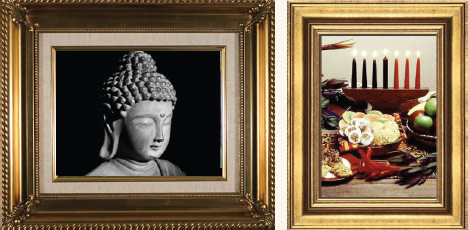A holiday for everyone

SCIENTOLOGY
Although Scientologists don't necessarily celebrate anything on December 25, they do celebrate Freedom Day on December 30. Freedom Day celebrates the official recognition in 1974 of the Church of Scientology in the United States.
SOME ABORIGINAL GROUPS
Many tribes accepted Christianity over 400 years ago, and have put their own stamp on Christmas traditions. It is custom to have a dance on Christmas Eve, where gifts are offered at the Christmas Crib — the manger. This idea comes from the many depictions in aboriginal culture of the great Thunderbird bringing glad tidings to braves in the fields. Scenes with the wise men of the traditional manger image are replaced by the chiefs representing the great Nations.
KWANZAA
Kwanzaa is a non-religious African- American holiday focusing on traditional African values of family, community responsibility, commerce and self-improvement. It is celebrated for seven days from December 26 to January 1, with each day representing a different principle: unity, self-determination, collective work and responsibility, cooperative economics, purpose, creativity and faith.
Despite some misconceptions, Kwanzaa is not a substitute for Christmas. The name Kwanzaa is derived from the phrase "matunda ya kwanza" which means "first fruits" in Swahili. The kinara (candle holder) is the centre of the Kwanzaa setting and represents the seven principles of the holiday.
OMISOKA
On December 31, Japanese families get ready to welcome the New Year. They clean their houses from top to bottom (�souji), and then install the decorations for New Year's Day. A kadomatsu is placed on each side of the front door. This decoration is made of pine branches (pine is a symbol of longevity, prosperity and purity), bamboo and straw and is said to have the power to attract good fortune inside the house.
ZARTUSHTNO-DISO
On December 26, Zoroastrians commemorate the death of their prophet, Zarathustra. Religious services are devoted to his memory and to the fravashis, the spirits of the dead. The Zoroastrian religion was founded in ancient Persia (modern Iran) by the prophet Zarathustra, who taught that there was one god, Ahura Mazda (wise lord), symbolized by a living flame.
HANUKKAH
Hanukkah is a Jewish festival celebrated on eight successive days beginning on the 25th day of Kislev, the third month of the Jewish calendar. This year, Hanukkah takes place from December 20 to 28, beginning at sunset on December 20. Hanukkah commemorates the rededication of the Temple in Jerusalem after its desecration under Antiochus IV. Spiritually, Hanukkah commemorates the Miracle of the Oil, when one day's worth of consecrated oil burned for eight consecutive days — enough time to prepare more oil for burning.
The most important Hanukkah ritual is the candle lighting. Each night, a candle is lit in a special candleholder called a menorah or a hanukkiah. The middle candle, the shamash, is lit every night, and is used to light each of the other candles.
CHRISTMAS
The history of Christmas dates back over 4,000 years. Though Christmas is currently thought of by many as a celebration of Jesus' birth, many Christmas traditions were celebrated centuries before Jesus. Traditions such as the 12 days of Christmas, feasts and the Yule log, gift-giving, carnivals (parades) with floats and carolers who sing while going from house to house can all be traced back to the early Mesopotamians.
WINTER SOLSTICE
Although Atheists don't believe in a higher power, many of them celebrate the Winter Solstice, which is the shortest day of the year. This year, the solstice falls on December 22 at 12:30 a.m. EST. Romans, Babylonians and ancient Greeks originally celebrated this day as a rebirth of the sun, sun god or saviour man-god and the beginning of a new year.
Today, Atheists spend this time with friends and family, share a meal and exchange gifts. It is seen as a time to set aside the religious divide of the season and portray the Winter Solstice as a universal, secular holiday with ties to nature.
YULE
Wiccans celebrate Yule in late December during Winter Solstice. Yule is a celebration of the rebirth of the Sun God and a time to honour the Horned God. Wiccans celebrate by decorating a tree, exchanging presents, hanging mistletoe and caroling. The traditions are similar to Christmas because both holidays are rooted in the Nordic, Celtic and Roman traditions. Many Wiccans burn a Yule log for 12 hours for good luck.
FESTIVUS
Festivus started in 1966 with former Reader's Digest editor Dan O'Keefe. It was not popularized until 1997 when O'Keefe's son, Daniel, a writer on the television sitcom Seinf eld , wrote the tradition into the script.
Festivus is celebrated on December 23 (although the original was celebrated in February) with a Festivus (aluminum) pole, instead of a Christmas tree. Those in attendance generally participate in Airing of Grievances. The celebration does not come to an end until the host of the party is wrestled to the floor and pinned, also known as The Feats of Strength. Festivus has caught on throughout Canada and the United States for those wanting to celebrate what was termed "a Festivus for the rest of us" without religious denominations or materialism attached to Christmas.
BODHI DAY
Bodhi Day is celebrated on December 8 every year by Pure Land Buddhists, who are mainly found in Japan and the United States. The original Bodhi Day was in 596 BC when Siddhartha Gautama, the historical founder of Buddhism, reached the founding principles of the faith, also known as the Four Noble Truths. Those principals include: Suffering is universal; The cause of suffering is Ignorance; Ignorance can be overcome; and the way to overcome Ignorance is the Eightfold Path.
If we have missed your specific holiday celebration let us know in a letter to the editor, fsuletters@fanshawec.ca, and we can include your festivities in an upcoming issue.













